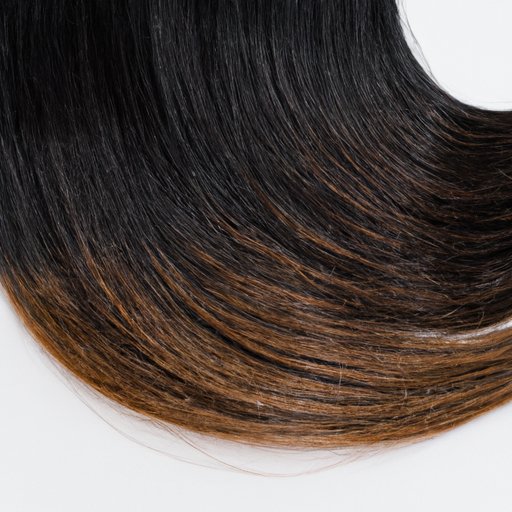Introduction
Having healthy hair is a key part of self-care. Not only does it look great, but it can also help maintain overall health. Knowing how to identify when your hair is not healthy is important so you can take steps to improve it. In this article, we’ll cover the basics of healthy hair and provide a comprehensive guide on how to know if your hair is healthy.
Definition of Healthy Hair
According to the American Academy of Dermatology (AAD), healthy hair should be strong, shiny, and free of any damage or breakage. It should have a natural bounce and movement, and not be weighed down by products or styling. Healthy hair should also be easy to comb and style, with minimal tangling or snagging.
Overview of Problem
Unfortunately, many people find it difficult to determine whether their hair is healthy or not. Factors such as genetics, styling habits, diet, and environmental stressors can all contribute to poor hair health. Additionally, it can be difficult to recognize signs of unhealthy hair until it’s too late. By understanding the signs of healthy hair and identifying potential problems, you can take steps to ensure that your hair remains healthy and beautiful.
Check the Texture of Your Hair
One of the easiest ways to tell if your hair is healthy is to check its texture. Healthy hair should feel soft and smooth, with no roughness or brittleness. You can also look for signs of damage, such as split ends, frizziness, and brittle strands. These are usually the first signs of unhealthy hair, so it’s important to address them right away.
What to Look For
When assessing the texture of your hair, look for signs of strength and flexibility. Healthy hair should be resilient and able to withstand heat and styling without breaking. It should also be able to retain moisture, which will help keep it looking and feeling healthy.
Signs of Unhealthy Hair
Unhealthy hair will often lack shine and luster. It may also appear dry and brittle, and be prone to breakage. Additionally, it may be difficult to manage and style, as it may become tangled or matted easily. Unhealthy hair may also have an unnatural texture, such as being overly coarse or limp.
Look at Your Scalp
Another way to assess hair health is to take a look at your scalp. Your scalp should be free of irritation, flakes, and excessive oiliness. Any of these could be a sign of a scalp condition or an imbalance in your scalp’s natural pH levels.
Irritation and Flakes
If you notice redness, itching, or flaking on your scalp, this could be a sign of dandruff or another scalp condition. In some cases, these conditions can cause hair loss or thinning. It’s important to consult a dermatologist if you notice any of these symptoms, as they can help diagnose the underlying cause and recommend a course of treatment.
Excessive Oiliness
Excessive oiliness is another common sign of an unhealthy scalp. Oily scalps can lead to clogged pores, which can lead to irritation, flaking, and other scalp issues. To prevent excessive oiliness, it’s important to use a gentle shampoo and avoid over-washing your hair.
Examine Your Hair Color
Your hair color can also be an indicator of hair health. If you notice that your hair is prematurely fading or turning gray, this could be a sign of poor health. Premature graying can be caused by a number of factors, including genetics, stress, and nutritional deficiencies.
Reasons for Poor Health
In addition to genetic factors, lifestyle choices and environmental stressors can also contribute to premature graying. According to a study published in the International Journal of Trichology, smoking, sun exposure, and dietary deficiencies can all contribute to premature graying.
Feel for Split Ends
Split ends are another sign of poor hair health. These are caused by a variety of factors, such as heat styling, excessive brushing, and chemical treatments. Split ends can be a sign of nutrient deficiency, as certain vitamins and minerals are essential for healthy hair growth.
Indication of Nutrient Deficiency
Nutrient deficiency can lead to weak and brittle hair, as well as split ends. Signs of nutrient deficiency include dull, lifeless hair, as well as thinning or shedding. If you suspect that you are deficient in certain vitamins or minerals, it’s important to talk to your doctor or nutritionist about supplementing your diet.
Prevention Strategies
To prevent split ends, it’s important to use the right tools and products. Avoid using harsh brushes and combs, as well as heat styling tools. It’s also important to use a deep-conditioning treatment once or twice a month to nourish and protect your hair.
Analyze Your Diet
Your diet also plays an important role in keeping your hair healthy. Eating a balanced diet that includes plenty of fruits, vegetables, and lean proteins can help ensure that you are getting all the necessary vitamins and minerals for healthy hair growth. Additionally, staying hydrated by drinking plenty of water can help keep your hair hydrated and nourished.
Necessary Vitamins and Minerals
Certain vitamins and minerals are essential for healthy hair growth. These include biotin, vitamin C, zinc, iron, and omega-3 fatty acids. Biotin helps strengthen and thicken hair, while vitamin C helps promote collagen production. Zinc and iron help support hair follicles and prevent hair loss, while omega-3 fatty acids help prevent dryness and brittleness.

Dietary Tips for Healthy Hair
In addition to eating a balanced diet, there are several dietary tips for maintaining healthy hair. Eating foods high in protein and iron, such as eggs, fish, and nuts, can help ensure that your hair is getting the nutrients it needs. Additionally, avoiding processed foods and eating plenty of fresh fruits and vegetables can help keep your hair healthy and strong.
See a Professional
If you’re still unsure of the health of your hair, it’s a good idea to consult a professional. A hairstylist or trichologist can assess the overall health of your hair and scalp and make recommendations on how to improve it. They can also suggest products and treatments that can help restore and maintain healthy hair.

Benefits of Consulting a Hairstylist or Trichologist
Consulting a hairstylist or trichologist can help you identify potential problems with your hair and scalp. They can also provide advice on products and treatments that can help improve your hair’s health. Additionally, they can offer personalized tips and tricks for styling and caring for your hair.
Assessment of Overall Hair Health
A hairstylist or trichologist can also assess the overall health of your hair. This includes examining the texture, color, and scalp for any signs of damage or poor health. Based on their assessment, they can recommend treatments and products that can help restore and maintain healthy hair.
Conclusion
Knowing how to identify if your hair is healthy is an important part of self-care. By understanding the signs of healthy hair and identifying potential problems, you can take steps to ensure that your hair remains healthy and beautiful. Checking the texture, looking at your scalp, examining your hair color, feeling for split ends, analyzing your diet, and seeing a professional are all important steps for maintaining healthy hair.

Summary of Steps for Healthy Hair
To maintain healthy hair, it’s important to check the texture, look at your scalp, examine your hair color, feel for split ends, analyze your diet, and see a professional. Additionally, it’s important to use the right tools and products, eat a balanced diet, and stay hydrated.
Final Remarks
By following these steps, you can ensure that your hair is healthy and beautiful. Additionally, if you notice any signs of unhealthy hair, it’s important to address them quickly to prevent further damage. With the right care and attention, you can have healthy, beautiful hair.
(Note: Is this article not meeting your expectations? Do you have knowledge or insights to share? Unlock new opportunities and expand your reach by joining our authors team. Click Registration to join us and share your expertise with our readers.)
